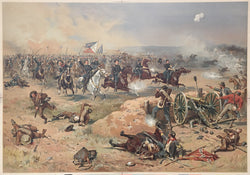Thure de Thulstrup. "Sheridan’s Final Charge at Winchester."
From Prang’s War Pictures. Boston: L. Prang, 1886-1887. 15 x 21 7/8. Chromolithograph. Full margins. Rare proof print with registration marks and color scale. Small registration hole in bottom right margin corner. Small stain in bottom margin just to the left of color scale. Else, very good condition.
Leading one of the many battles of Winchester, Virginia during the American Civil War, Gen. Phillip Sheridan rides his favorite horse, Rienzi, in a cavalry charge. So memorable was the battle for the war hero that he later changed the horse’s name to Winchester.
Proofs, such as this example, were made for each print in the series. The lithographer marked each side of the image with a cross so that each color plate would align correctly. A hole in the bottom right corner also allows the lithographer to place the sheet of paper in the same spot for the multiple passes through the press to achieve the required colors. The color scale at bottom shows the sixteen colors needed to create this image. When the prints were issued to the public the registration marks and the color scale were removed or the margins were trimmed to the colored border or image.
A print from a striking series of images of the rare and important Civil War series originally issued by Louis Prang between 1886 and 1888 and later reissued later by the American Lithographic Co. In the early 1880s, Century Magazine had issued a very popular work entitled Battles and Leaders of the Civil War, and the Kurz & Allison firm had issued a large chromolithograph of Gettysburg. In response to these, Louis Prang decided to issue a portfolio of 18 elaborate chromolithographs of important battles of the war. Prang termed his prints “aquarelle facsimile prints” to distinguish them from “mere” chromos. Prang claimed they were made by a “new and secret process”, but primarily they were chromos done without any line work. They were based on watercolors commissioned by Prang and they were intended to be naturalistic and accurate, for Prang was aiming these prints for veterans and their descendants. Prang got testimonials on their accuracy from prominent veterans and he included detailed text on the battles involved. The prints were quite popular, helping to create a great surge in patriotic nostalgia about the war.
There were 18 prints in all: 6 of eastern battles, 6 of western battles, and 6 naval images. There was intended to be something for everyone, and Prang focused mostly on heroes who were still living at the time. They were issued either in a portfolio or separately for framing. At first they were issued in parts over time, but eventually were packaged into three groups: East/West/Naval.

![Thulstrup, Thure de "Sheridan’s Final Charge at Winchester" [Proof]](http://philaprintshop.com/cdn/shop/files/prangproofwinchesterc_{width}x.jpg?v=1698870593)
![Thulstrup, Thure de "Sheridan’s Final Charge at Winchester" [Proof]](http://philaprintshop.com/cdn/shop/files/prangproofwinchester_{width}x.jpg?v=1698870597)
![Load image into Gallery viewer, Thulstrup, Thure de "Sheridan’s Final Charge at Winchester" [Proof]](http://philaprintshop.com/cdn/shop/files/prangproofwinchesterc_110x110@2x.jpg?v=1698870593)
![Load image into Gallery viewer, Thulstrup, Thure de "Sheridan’s Final Charge at Winchester" [Proof]](http://philaprintshop.com/cdn/shop/files/prangproofwinchester_110x110@2x.jpg?v=1698870597)
